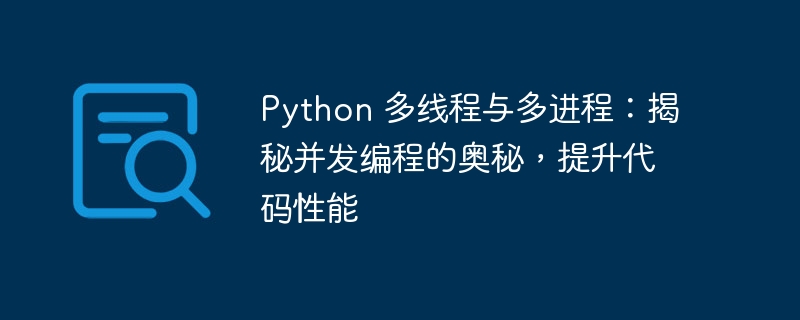Home >Backend Development >Python Tutorial >Python multi-threading and multi-process: Reveal the secrets of concurrent programming and improve code performance
Python multi-threading and multi-process: Reveal the secrets of concurrent programming and improve code performance
- WBOYWBOYWBOYWBOYWBOYWBOYWBOYWBOYWBOYWBOYWBOYWBOYWBforward
- 2024-02-25 09:58:20510browse

Multi-threading and multi-process are the two main ways of Concurrent programming. They both allow the program to perform multiple tasks at the same time, thus Improve program performance. However, there are some differences between them that are important to understand in order to choose the right approach.
Multithreading
Multi-threading refers to creating multiple threads in a process, and these threads share the same memory space. This means they can access the same variables and objects, but it also means they can interfere with each other. Multithreading is better suited for I/O-intensive tasks because they can handle multiple requests simultaneously without blocking each other.
Python Using multi-threading
InPython, you can use the threading module to create and manage threads. To create a thread, you can use the threading.Thread() function, which requires a callable object as a parameter. For example, the following code creates a simple thread that prints a message in an infinite loop:
import threading
def print_message():
while True:
print("Hello, world!")
thread = threading.Thread(target=print_message)
thread.start()
Run this code and you will see the message "Hello, world!" being printed continuously. multi-Progress
Multi-process refers to creating multiple processes on one computer, each process has its own memory space. This means that they cannot access each other's variables and objects, but it also means that they cannot interfere with each other. Multiprocessing is better suited for CPU-intensive tasks because they can perform multiple tasks simultaneously without blocking each other.
Using multiple processes in Python
In Python, you can use the
multiprocessing module to create and manage processes. To create a process, you can use the multiprocessing.Process() function, which requires a callable object as a parameter. For example, the following code creates a simple process that prints a message in an infinite loop:
import multiprocessing
def print_message():
while True:
print("Hello, world!")
process = multiprocessing.Process(target=print_message)
process.start()
Run this code and you will see the message "Hello, world!" being printed continuously. Comparison of multi-threading and multi-process
The following table compares the advantages and disadvantages of multi-threading and multi-process:
| Multithreading | multi-Progress | |
|---|---|---|
| yes | no | |
| possible | impossible | |
| I/O intensive tasks | CPU intensive tasks | |
threading |
multiprocessing |
Multi-threading and multi-process are the two main ways of
concurrencyprogramming in Python, both of which can greatly improve code performance. However, there are some differences between them that are important to understand in order to choose the right approach. For I/O-intensive tasks, you can use multithreading, and for CPU-intensive tasks, you can use multiple processes.
The above is the detailed content of Python multi-threading and multi-process: Reveal the secrets of concurrent programming and improve code performance. For more information, please follow other related articles on the PHP Chinese website!

